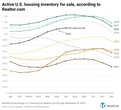Back-to-school season is in full swing, and with it comes the excitement of new teachers, new friends, and fresh beginnings. But for millions of children, this time of year also brings relief—because for the first time in months, they once again have consistent access to the food they need to concentrate, participate, and succeed.
While summer conjures images of vacations and play for many children, it can be a time of increased hunger and skipped meals for families working hard to make ends meet. When schools close, so do their cafeterias, meal programs, and pantries, resulting in more than 20 million kids losing their most reliable source of daily nutrition. And with rising food costs and a worsening job market, parents are finding it harder than ever to put nutritious meals on the table.
Of the parents surveyed, more than 1 in 3 said they worried about running out of food this past summer, while 70% said inflation and rising food prices made it harder to afford groceries. And nearly 2 in 3 parents expect food costs to continue rising this year, adding to the stress of already strained budgets. The result is a season that, for too many families, is less about carefree childhood and more about hard choices between food, rent, and gas.
Investing in Nutrition Is Investing in the Future
The costs of hunger extends far beyond the dinner table, demonstrating that hunger isn’t only a moral crisis; it’s an educational and economic crisis as well. Studies confirm that children experiencing food insecurity are sick more often, hospitalized more frequently, and may face developmental deficiencies that alter the architecture of their brains. They may also struggle to concentrate in classrooms, with 83% of parents surveyed by No Kid Hungry saying their children can’t focus when hungry, and 88% reporting that school meals directly improve learning.
The costs of a child missing a meal doesn’t end with childhood. It is linked to lower academic performance, behavioral challenges, and reduced lifetime earnings. Children who grow up food insecure often enter the workforce with fewer opportunities and greater barriers to success. But the impact doesn’t stop there.
Childhood hunger reverberates across society—contributing to higher healthcare costs, increased demand for special education services, and diminished economic productivity. In fact, research shows that child hunger costs the U.S. economy $160 billion annually in lost potential and increased public spending.
Closing the hunger gap together
Hunger isn’t a supply problem—it’s a systems problem. With more than enough food in the U.S., hunger is a solvable issue when we all work together, especially through innovative community and business partnerships. People facing hunger have told us that they don’t want charity; they want lasting solutions. Increasingly, companies across industries are stepping up, not only through food donations, cash grants, and volunteers, but by using their size and influence to advocate for stronger policies that protect families. In addition, some are launching large-scale programs—such as PepsiCo’s Food for Good—that leverage corporate capabilities to source, pack, and deliver millions of cost-effective, nutritious meals each year, demonstrating how business can directly help close the hunger gap.
Federal nutrition programs like the Supplemental Nutrition Assistance Program (SNAP), Summer EBT, and school meals are among the most effective solutions we have. Every dollar invested generates up to $2 in economic return–including healthier kids, better school performance, and stronger earning potential over a lifetime. These programs have already reduced child hunger by 33% and eased stress for working parents, with two-thirds noting school meals lower their family’s anxiety. Rolling them back would not just hurt families today, but undercut America’s workforce and economic competitiveness tomorrow.
That’s why corporate leadership is essential. When business voices join community leaders in calling for stronger nutrition programs—and pair that advocacy with innovation like mobile meal hubs or public-private partnerships—the impact multiples. The choice is clear: Cutbacks carry devastating costs while investment in child nutrition pays dividends for generations. Without collective action, reductions in nutrition spending will carry devastating costs for years to come.
Feeding potential and fueling growth
The return on investing in childhood food access is both immediate and generational. Every meal served to a child today protects their health, boosts their learning, and fuels their potential to contribute to tomorrow’s economy. Eleven-year-old Elijah, who receives free breakfast and lunch at school, put it simply: “When I’m hungry, I get tired or I’ll get distracted. But when I’m not, I’m on-task and I can focus.” With consistent meals, Elijah isn’t just able to concentrate, he’s thriving in his passion for robotics. “If I’m full, I’m ready for whatever happens,” he said.
Elijah’s story is one of millions. Summer programs that provide meals to children who rely on free or reduced-price meals during the school year are especially critical and have been shown to decrease food insecurity and mitigate summer learning loss.
Partnerships are already proving what’s possible. Since 2009, PepsiCo and the PepsiCo Foundation have invested over $75 million in Food for Good, expanding access to nutritious meals for children after school, on weekends, and during the summer. Through this investment, Food for Good partners with food banks—including the Feeding America network, which provided 30 million meals to children last summer. Together, these efforts demonstrate the power of public-private collaboration to reach children at scale, ease family budgets, and build healthier, more resilient communities.
Nourishment now is prosperity later
Ensuring kids have year-round access to food is one of the smartest investments we can make in human capital. It reduces costs, boosts productivity, and strengthens the workforce. Every nourished child is healthier today and better prepared to become the innovators and leaders who will shape a more prosperous tomorrow.











No comments